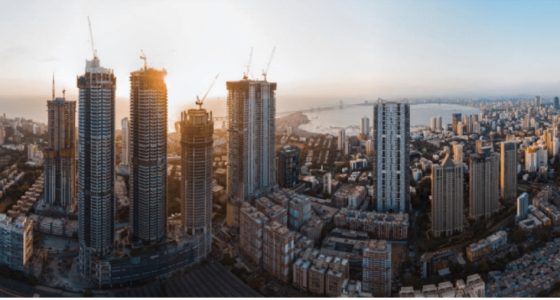Office net absorption is expected to be up 50% Y-o-Y, residential sales to touch 2 lakh units, and warehousing & light manufacturing* to surpass 40 million sq. ft by the end of 2022
The office, residential as well as warehousing segments have performed extremely well in 2022 and is expected to continue their upward trajectory in 2023 as well, according to JLL’s Year ender ‘The 2022 story: Indian real estate’s rise from the lows.”
Net absorption in office space for 2022 is likely to be up ~50% Y-o-Y with 2023 expected to further build on the gains of this year. Supply addition and forecast pipeline remain strong with institutional share at 30%; headline vacancy is likely to inch up within a tight range. The net absorption in 2023 for office space is expected to be at 37-40 million sq ft. The net absorption for the first nine months of 2022 (Jan-Sep 2022) is at a three-year high of 30.3 million sq. ft and on track to match the 5-year average (2015-2019) for the full year.
The good news comes from the green front with India’s Grade A office stock’s green certifications expected to surpass 45% by end of 2022 and likely to inch to the 50% mark by end of 2023.
The core market vacancies have remained in single digits and are expected to remain so, though short-term vacancies may inch up as demand momentum gets slightly softened in the wake of global headwinds. There is a slight decline in space take-up by tech firms, but manufacturing, healthcare, and flex are major movers in 2022 and are also expected to remain big drivers of office demand in 2023. The tech, as well as the GCC story, will continue to support the office market momentum in 2023 as well
“The year 2022 has been the year of a sustained turnaround for the Indian real estate sector, after two COVID-impacted years. The Indian office markets are on track to record net absorption levels like the pre-COVID 5-year average with a potential upside next year clearly outlining the resilience amid India’s dominance as the outsourcing/offshoring hub of the world and its innovation ecosystem creating new office demand. The turnaround in the residential sector has been nothing short of remarkable, with the sector poised to surpass decadal highs in apartment sales numbers. India’s warehousing & light manufacturing sector is expected to cross 40 million sq. ft in space demand in 2022, the highest ever with further growth anticipated driven by 3PL and the growth in the urban logistics landscape. ESG and rising input costs have also been key themes defining the in real estate this past year,” said Dr Samantak Das, Chief Economist and Head of Research and REIS, India, JLL.
“We will keep our eyes on the evolving headwinds, with inflationary pressures and global growth in our rear-view mirror. The office, residential and warehousing segments are all on track to improve further on their 2022 performance and we will watch the next year unfold with anticipation. For real estate, concrete ESG actions and asset pricing will also be key defining elements in the next year,” he added further.
Flex (ing) it’s way up
Flex is expected to nearly match its peak activity of 2019 in terms of space take-up by operators with managed and bespoke enterprise models driving growth in this segment. Flex is now a key part of portfolio strategy. Hybrid working and strategic occupier diversification to Tier II and III cities amid talent dispersion were key elements to office space planning in 2022. With the “Return to Work” gaining full force, real estate planning will center around talent mobility, healthy workplaces, and employee value propositions. The 9-month flex seat take-up is already at an all-time peak of ~95,000 seats, with the year likely to end more than 120,000 seats. Similar growth momentum is expected in 2023 with flex integral to workplace strategy, return to work, and creating new-age offices allowing for zero CAPEX spend for a fully managed, ‘space as a service offering.
Living it up: Residential segment at new highs, affordability may be impacted
The residential segment has witnessed the smartest and the fastest recovery with annual sales in 2022 expected to surpass 200,000 units, the highest in over a decade and near next to the 2010 sales of 216,762 units. Quarterly residential sales were over 50,000 units in each of the first three quarters of 2022. As incomes get adversely impacted by inflationary pressures and global headwinds, the affordability synergy prevailing in the last six months has been challenged. While affordability is likely to be impacted, the slowing momentum looks to be temporary with the country’s focus on economic growth along with the likely easing of inflationary pressures.
The trend of launching plotted developments and independent floors is expected to grow with buyer preferences more toward such products. Developers also get the advantages of faster execution and quick inventory liquidation with such products.
Apart from the affordable and mid-segment, the traction is expected to take place in the premium segment as well backed by launches by established developers in prime locations. Moreover, there is rising demand for bigger homes with good amenities. It is expected that the market share of established and credible developers will increase further with buyers preferring developers with a proven track record, robust financial strength, and execution capability. The sector is expected to witness consolidation at a faster clip with more joint ventures and development management contracts likely to be seen.
Developers have moved away from their own aspirational/dream projects to more relevant and customer-oriented ones. Developers’ strategies include adopting technology to enhance efficiency, focusing on products that are generating demand, and incorporating the concept of sustainable and green buildings to consider the health and well-being aspects of the prospective buyers.
Warehousing & Light manufacturing net absorption expected to reach ~44 million sq. ft. in 2023
The warehousing & light manufacturing demand in 2022 is estimated to cross 40 million sq ft. by 2022-end surpassing the levels of 2021. Moreover, the momentum of the market is expected to continue in the next year with the net absorption projected to reach ~44 million sq. ft in 2023. The demand in Grade A space has increased contributing more than ~ 65% of the total demand in the market.
In the year 2022, there is an increased interest from institutional developers and investors in the warehousing market of India. This has led to the new supply in the market especially Grade A space.
Warehousing & Light manufacturing rents are expected to continue to increase in 2023
The year 2022 has witnessed upward rent corrections after being stable for the last three years with rental appreciation observed. The rents are expected to grow at ~4-5% y-o-y growth rate with the increasing demand from specialized manufacturing sectors, 3PL, and Retail companies that require technically specialized facilities. As the Grade A spaces are likely to be in favor by top international and domestic occupiers, the rent growth of Grade A is expected to be higher than Grade B space.
Future trends look forward to in 2023
Office:
- Institutional players account for a 30% share of upcoming supply in the next 12 months with 25-30% pre-leasing levels. ESG considerations becoming key to space decisions
- Tech will dominate as outsourcing/offshoring rises with corporate digital spending increasing. Managed workspaces to gain further momentum
- Global economic headwinds to impact leasing decisions: Some delayed decision-making as businesses look at macroeconomic signals before committing capital for new offices
Residential
- Apart from the affordable and mid-segment, the traction is expected to take place in the premium segment as well backed by launches by established developers in prime locations.
- Digital play is taking the center stage and developers are changing the marketing strategy by giving more focus on digital interplay with close support from CRM, digital, and technology teams.
Warehousing & Light manufacturing
- The increasing expansion needs to be steered by light manufacturing, retail and 3PL players have led to the development of Grade A warehouses in Tier II and III cities. This is due to the demographic dividends, increased internet penetration (push for Digital India), rising levels of disposable income, and a higher standard of living.
- Some Tier II & III warehousing clusters are seeing good traction driven by the existing large-scale industrial activities, proposed industrial and freight corridors, better infrastructure connectivity, high agricultural produce and aspiring young generations, will emerge as strong markets.
- Urban Logistics to gain importance with growth for in-city warehouse space for faster deliveries to end users with growth in 3PL and e-commerce segment. 3PL is penetrating deep inside the cities in the busiest commercial, retail, and residential areas. Constrained supply is also driving re-positioning / usage change of existing assets like malls, high-street retail, marriage halls, auditoriums, showrooms & workshops.
Also Read: Net absorption in office space up 11% Q-o-Q at 9.86 million sqft









